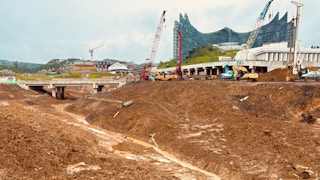Around 3,000 to 5,000 people visit Ibu Kota Nusantara (IKN), Indonesia’s under-construction capital in East Kalimantan on the island of Borneo, every day. Some are from the nearby oil and gas towns of Samarinda and Balikpapan, others from as far away as Java, Sulawesi or Bali.
To continue reading, subscribe to Eco‑Business.
There's something for everyone. We offer a range of subscription plans.
- Access our stories and receive our Insights Weekly newsletter with the free EB Member plan.
- Unlock unlimited access to our content and archive with EB Circle.
- Publish your content with EB Premium.
“People want to see a new, modern Indonesian city,” an electrical engineer working on what is Asia’s largest construction project told Eco-Business during a visit to the site last November.
Feelings about the new city are mostly positive. Visitors to the site, particularly those from Kalimantan, are excited to see Indonesia’s centre of political and economic gravity shift eastwards. Revenues from the province’s vast resources of minerals and palm oil have traditionally flowed to Jakarta, the sinking, polluted metropolis on the island of Java the new city is being built to replace.
“Previously, Kalimantan could only watch Java rapidly develop, even though Kalimantan provides funding for Java’s development from gold mining, oil, nickel and much more,” said Nadhila Shabrina, a well-known clothing designer from Balikpapan. “The people of Kalimantan are always called backward because we don’t have the same development opportunities. But Java will be afraid when IKN is established, because Java can only produce food. Kalimantan has everything.”
Dewi, a 24-year-old research assistant who works in a laboratory in Balikpapan that refines palm oil into biodiesel, said she hoped the new city will mean better hospitals and schools in Kalimantan. Reliable power and water supply are still major problems in the province, and the new city could mean improved infrastructure and a fairer distribution of wealth, she said.
Steven Tagarnana, a 70-year-old unemployed man from Balikpapan, said he hopes Nusantara will mean more jobs in the area. The megaproject is expected to generate 4 million jobs in the region over the next 15 years, principally in construction, transportation and hospitality. Indonesia’s manpower minister has said that jobs will be focused on boosting Kalimantan’s competitiveness in advanced and sustainable technology.
Others wonder why Nusantara is being built in what feels like the middle of nowhere. “To see a palace emerge out of the jungle is surreal,” said the daughter of an oil and gas executive from Balikpapan who withheld her name. Sited in an area split between North Penajam Paser and Kutai Kartanegara regencies in East Kalimantan, it is a remote, rural area of palm oil plantations and forests, with a smattering of villages dotted on a landscape of rolling hills. The site is a three-hour public bus ride inland from the port city of Balikpapan, although the journey time is expected to be cut to one hour once a new road is built. A new airport is in the works.
Vistors arriving by bus are deposited in a canopied rest area, where they queue for an electric bus that ferries them to the main attraction: the presidential palace. On billboards around the rest area, Nusantara is pitched as “the city of tomorrow”, a place where “technology meets sustainability”.

Visitors to Nusantara queue for an hour at a rest stop to wait for a free ride in an electric bus to see the presidential palace. Image: Robin Hicks / Eco-Business

Petrol-powered motorbikes are parked by an unused electric vehicle charging point outside of the rest area that welcomes visitors to the site of Indonesia’s new capital. Image: Robin Hicks / Eco-Business

A man smokes a cigarette outside the visitor rest area. An estimated 3,000 to 5,000 people from all over Indonesia visit the site every day, and most are from Kalimantan. Image: Robin Hicks / Eco-Business

An electric bus shuttles visitors to the main attraction: the presidential palace. Image: Robin Hicks / Eco-Business
Though it is still early days – construction only began in 2022, with an expected completion date of 2045 – much of the site is essentially a mud pit, with large patches of flattened forest interspersed with a few gleaming new buildings, most of which are unfinished. Some construction sites are shielded by hoardings that bear images of forests and the words “Future smart forest city”.
Zena, a 16 year-old student from Penajam Paser Utara who chose not to disclose her full name, said Nusantara makes her proud because of its use of new technology. Though the digital infrastructure has yet to be installed, the city is to run on a smart energy grid that will use mostly renewable energy, according to IKN marketing. The streets will be populated with electric vehicles and autonomous shuttles, surveillance systems powered by artificial intelligence will monitor traffic and emissions and internet-of-things sensors will be deployed to monitor air quality, forest fires, and water levels.
The main attraction is the spectacular eagle-shaped Garuda Palace, which has been billed as an architectural and construction marvel that showcases Indonesia’s capabilities in art, science, and technology. The Garuda Palace is located at one end of the Nusantara presidential complex that stretches across 56 hectares of rolling green features and ponds, and is flanked by public administration buildings. The only other buildings of note that have been completed are the five-star, US$350-per-night Swiss Hotel and some high-rised residential blocks for civil servants.
Though the presidential complex has been designed with natural cooling in mind, with greenery running on and around concrete structures, some visitors feel that the site is too hot. “It is much hotter than Balikpapan, maybe because they cut the forest,” said Nadhila.
A lot more deforestation is still to come, as the city will eventually cover 2,560 square kilometres inland from the coast. Dewi said she is conscious of losing forests to create the new city, as Borneo is known as the “lungs of the planet” and is home to endemic and rare wildlife.

The Nusantara site has been rapidly developed since construction began in 2022. Images: NASA
A barista who works at a coffee shop in Balikpapan, who preferred not to be named, said he got sunburnt from walking around the site and now has a sore throat from breathing in construction dust.

Visitors brave the rain and heat as they walk around the Nusantara presidential complex. Image: Robin Hicks / Eco-Business

The Nusantara presidential complex is situated among lush green features and waterways. Some visitors to the site say it is surreal to see a palace emerge out of the jungle. The Garuda Palace was designed by Indonesian architect Nyoman Nuarta. Image: Robin Hicks / Eco-Business

Visitors take photos in front of the Garuda presidential palace. The signature feature is a 44-metre tall eagle monument made from copper and bronze. Image: Robin Hicks / Eco-Business
Though outgoing president Joko Widodo, who launched the project, has hailed Nusantara his “green” and “inclusive” dream, some wonder just how inclusive the new city will be. The daughter of the oil and gas executive said she believed Nusantara has been designed mainly with the elites in mind, which rankles considering a recent increase in tax is being used to help fund the construction of IKN.
Some 250,000 people, mostly civil servants, are to eventually move from Jakarta to Nusantara, with the relocation expected to be complete by 2029. The relocation of civil servants was delayed last year, as housing complexes and digital infrastructure are still unfinished. The local population is expected to climb steadily as the new city takes shape. East Kalimantan’s annual population growth rate of just under 4 per cent is projected to double over the next 18 years, although the government has said it will cap the population of IKN at 2 million to avoid overcapacity.
The surge in population is likely to mean traffic congestion in the region. Balikpapan is, by Indonesian standards, not too crowded and the traffic is bearable, even at rush hour, observed residents whom Eco-Business spoke to. That could change as more people flock to the new capital. Dewi worries that the influx of people from around the country could also mean a spike in crime. East Kalimantan is known to be a relatively safe region.

Workers on site at Nusantara presidential complex. Around 70 per cent of construction workers assigned to build the new capital are from Kalimantan, the rest are from elsewhere in Indonesia. Image: Robin Hicks / Eco-Business

A unplugged bank of solar panels at the Nusantara presidential complex. The city will be powered by smart energy grids that use mostly renewable energy. Image: Robin Hicks / Eco-Business

An overflowing rubbish bin stands outside a sign at the entrance to the presidential complex. The city is to be built using circular economy principles including an “all-around” waste management system, according to officials, who are aiming for 60 per cent of Nusantara’s waste to be recycled by 2045; the rest will be incinerated or landfilled. Image: Robin Hicks / Eco-Business
There is an overwhelming sense that Indonesian visitors to Nusantara want to be proud of the new city. But some worry that funds will run out before the project is finished, leaving a white elephant carved out of the jungle.
The government is to finance the initial phase of the US$35 billion development, but the rest – 80 per cent of the project’s value – must come from private investment, which has been slow to materialise; less than US$4 billion of private capital has been raised to date. A Balikpapan-based cleaning services contractor Eco-Business spoke to complained that he wasn’t paid for work done at the Nusantara site, which suggests that cash flow is a problem for the project’s developers.
Experts have warned that Nusantara could become another Forest City, the $100 billion development project in Malaysia’s Johor state that ran into financial trouble and is now only 10 per cent completed and 1 per cent occupied. The China-backed project is reportedly US$200 billion in debt and is a “ghost town” even though it is a stone’s throw from Singapore.
Though Nusantara has been backed by new president Prabowo Subianto – who has vowed to complete the project started by his predecessor Joko Widodo – the new city could face similar issues to Forest City, as investors fret about construction delays and environmental impact in a region already ravaged by deforestation from agriculture and mining.
The rights of Indigenous peoples and local communities who have lost their homes to the development is another concern. “Before the forest was opened up to start building IKN, land was grabbed from the native Dayak people,” said the relative of the oil and gas executive. “I believe that if we want to build something new, we have to start it with a pure heart. If we don’t, I worry that bad things will happen.”


